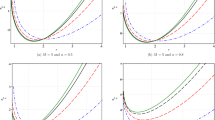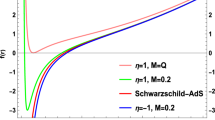Abstract
The Stefan-Boltzmann law can estimate particle emission power and lifetime of a black hole. However, in modified gravity theories, new parameters in the action can cause qualitative changes in thermodynamic quantities, thus obtaining specific thermodynamic properties often requires complicated calculation with higher degree equations. In this work, we aim to provide a general model-independent description of the evolution of AdS black holes, using Gauss-Bonnet massive gravity as an example. We prove that the impact factor of an infinitely large AdS black hole is equal to the effective AdS radius, and the black hole is able to evaporate an infinite amount of mass in finite time, so that the lifetime of the black hole depends on the final state temperature in the evaporation process. The black hole will evaporate out when the final state temperature diverges and will transform into a remnant when the temperature is zero. Since we have analyzed massive gravity in detail, we can introduce the Gauss-Bonnet term to study how it affects the thermodynamic quantities. We obtain the final states for different parameter intervals, study the qualitative properties of black hole evaporation, and classify the associated cases. This method can also be applied to other models.









Similar content being viewed by others
Data Availability
No Data associated in the manuscript.
Notes
We can not discuss infinitely large black hole in de Sitter spacetime. Given the relevant parameters, there is an upper limit to the mass of black holes in de Sitter spacetime, so increasing the radius of a black hole causes its radius to converge to the cosmological horizon, eventually reaching the Nariai limit [45, 46]
Note that our action here is not exactly the same as in the [55]. In particular, our cosmological constant are introduced by hand, whereas in [55] the effective cosmological constant term emerged from the graviton mass. But this does not matter, because the final form of the metric and the black hole thermodynamics are still the same.
Here we assume that \(r_p\) must exists. If \(r_p\) does not exist, the impact factor is directly \(\ell _{\text {eff}}\).
In the Schwarzschild AdS case, we have \(a=0\) and \(n=1\), so the \(r_p\sim M \sim r_+^3\).
We could also get the Gauss-Bonnet result first and then introduce massive gravity as a correction. However, the massive gravity itself is more complicated and has several parameters, while there is only one parameter \(\alpha \) in the Gauss-Bonnet gravity, so it is more convenient to use the Gauss-Bonnet term as a correction.
For \(\alpha =0\), in \(\gamma ^2\ell ^2<3(\varepsilon +1)\), the roots are not real, and in \(\gamma ^2\ell ^2>3(\varepsilon +1)\), \(\gamma >0\), \(\varepsilon +1>0\), the roots are negative [55].
Under certain parameter choices, points b and c may no longer exist, and M will become a monotonically increasing function of \(r_+\). This is similar to the case of \(\sqrt{-2\alpha }>r_c\), where the final states of the black hole are \(T = \infty \) and the black hole will have completely evaporated.
References
M.E. Fierz, W. Pauli, On relativistic wave equations for particles of arbitrary spin in an electromagnetic field. Proc. Roy. Soc. Lond. A 173, 211 (1939). https://doi.org/10.1098/rspa.1939.0140
P.V. Nieuwenhuizen, On ghost-free tensor lagrangians and linearized gravitation. Nucl. Phys. B 60, 478 (1973)
H. van Dam, M.J.G. Veltman, Massive and massless yang-mills and gravitational fields. Nucl. Phys. B 22, 397 (1970)
V.I. Zakharov, Linearized gravitation theory and the graviton mass. JETP Lett. 12, 312 (1970)
A.I. Vainshtein, To the problem of nonvanishing gravitation mass. Phys. Lett. B 39, 393 (1972)
D.G. Boulware, S. Deser, Can gravitation have a finite range? Phys. Rev. D 6, 3368 (1972). https://doi.org/10.1103/PhysRevD.6.3368
C. de Rham, G. Gabadadze, Generalization of the fierz-pauli action. Phys. Rev. D 82, 044020 (2010). https://doi.org/10.1103/PhysRevD.82.044020
C. de Rham, G. Gabadadze, A.J. Tolley, Resummation of massive gravity. Phys. Rev. Lett. 106, 231101 (2011)
S.F. Hassan, R.A. Rosen, On non-linear actions for massive gravity. JHEP 07, 009 (2011). https://doi.org/10.1007/JHEP07(2011)009
S.F. Hassan, R.A. Rosen, Resolving the ghost problem in nonlinear massive gravity. Phys. Rev. Lett. 108, 041101 (2012). https://doi.org/10.1103/PhysRevLett.108.041101
S.F. Hassan, R.A. Rosen, A. Schmidt-May, Ghost-free massive gravity with a general reference metric. JHEP 02, 026 (2012). https://doi.org/10.1007/JHEP02(2012)026
S. Deser, K. Izumi, Y.C. Ong, A. Waldron, Massive gravity acausality redux. Phys. Lett. B 726, 544 (2013)
S. Deser, K. Izumi, Y.C. Ong, A. Waldron, Problems of massive gravities. Mod. Phys. Lett. A 30, 1540006 (2015). https://doi.org/10.1142/S0217732315400064
G. D’Amico, C. de Rham, S. Dubovsky, G. Gabadadze, D. Pirtskhalava, A.J. Tolley, Massive cosmologies. Phys. Rev. D 84, 124046 (2011). https://doi.org/10.1103/PhysRevD.84.124046
A. De Felice, A. Emir Gumrukcuoglu, C. Lin, S. Mukohyama, On the cosmology of massive gravity. Class. Quant. Grav. 30, 184004 (2013). https://doi.org/10.1088/0264-9381/30/18/184004/meta
D.G. Boulware, S. Deser, String generated gravity models. Phys. Rev. Lett. 55, 2656 (1985). https://doi.org/10.1103/PhysRevLett.55.2656
C.G. Callan Jr., R.C. Myers, M.J. Perry, Black holes in string theory. Nucl. Phys. B 311, 673–698 (1989). https://doi.org/10.1016/0550-3213(89)90172-7
R.G. Cai, Gauss-Bonnet black holes in AdS spaces. Phys. Rev. D 65, 084014 (2002). https://doi.org/10.1103/PhysRevD.65.084014
M. Cvetic, S. Nojiri, S.D. Odintsov, Black hole thermodynamics and negative entropy in de Sitter and anti-de Sitter Einstein-Gauss-Bonnet gravity. Nucl. Phys. B 628, 295–330 (2002)
T. Torii, H. Maeda, Spacetime structure of static solutions in Gauss-Bonnet gravity: neutral case. Phys. Rev. D 71, 124002 (2005). https://doi.org/10.1103/PhysRevD.71.124002
R.A. Konoplya, A. Zhidenko, Long life of Gauss-Bonnet corrected black holes. Phys. Rev. D 82, 084003 (2010). https://doi.org/10.1103/PhysRevD.82.084003
W. Xu, H. Xu, L. Zhao, Gauss-Bonnet coupling constant as a free thermodynamical variable and the associated criticality. Eur. Phys. J. C 74, 2970 (2014). https://doi.org/10.1140/epjc/s10052-014-2970-8
H. Xu, W. Xu, L. Zhao, Extended phase space thermodynamics for third order Lovelock black holes in diverse dimensions. Eur. Phys. J. C 74(9), 3074 (2014). https://doi.org/10.1140/epjc/s10052-014-3074-1
H. Xu, Z.M. Xu, Maxwell’s equal area law for Lovelock thermodynamics. Int. J. Mod. Phys. D 26(04), 1750037 (2016)
Y. Sun, H. Xu, L. Zhao, Thermodynamics and holographic entanglement entropy for spherical black holes in 5D Gauss-Bonnet gravity. JHEP 1609, 060 (2016). https://doi.org/10.1007/JHEP09(2016)060
R.A. Konoplya, A. Zhidenko, Eikonal instability of Gauss-Bonnet-(anti-)-de Sitter black holes. Phys. Rev. D 95(10), 104005 (2017). https://doi.org/10.1103/PhysRevD.95.104005
R.A. Konoplya, A. Zhidenko, Quasinormal modes of Gauss-Bonnet-AdS black holes: towards holographic description of finite coupling. JHEP 09, 139 (2017). https://doi.org/10.1007/JHEP09(2017)139
D. Glavan, C. Lin, Einstein-gauss-bonnet gravity in four-dimensional spacetime. Phys. Rev. Lett. 124(8), 081301 (2020). https://doi.org/10.1103/PhysRevLett.124.081301
H. Lu, Y. Pang, Horndeski gravity as \(D \rightarrow 4\) limit of Gauss-Bonnet. Phys. Lett. B 809, 135717 (2020)
M. Guo, P.C. Li, Innermost stable circular orbit and shadow of the \(4D\) Einstein-Gauss-Bonnet black hole. Eur. Phys. J. C 80(6), 588 (2020). https://doi.org/10.1140/epjc/s10052-020-8164-7
C.Y. Zhang, P.C. Li, M. Guo, Greybody factor and power spectra of the Hawking radiation in the \(4D\) Einstein-Gauss-Bonnet de-Sitter gravity. Eur. Phys. J. C 80(9), 874 (2020). https://doi.org/10.1140/epjc/s10052-020-08448-z
R.A. Konoplya, A.F. Zinhailo, Grey-body factors and Hawking radiation of black holes in 4D Einstein-Gauss-Bonnet gravity. Phys. Lett. B 810, 135793 (2020). https://doi.org/10.1016/j.physletb.2020.135793
S. Mahapatra, A note on the total action of 4D Gauss-Bonnet theory. Eur. Phys. J. C 80(10), 992 (2020). https://doi.org/10.1140/epjc/s10052-020-08568-6
J. Arrechea, A. Delhom, A. Jiménez-Cano, Inconsistencies in four-dimensional Einstein-Gauss-Bonnet gravity. Chin. Phys. C 45(1), 013107 (2021). https://doi.org/10.1088/1674-1137/abc1d4
R. Kumar, S.G. Ghosh, Rotating black holes in \(4D\) Einstein-Gauss-Bonnet gravity and its shadow. JCAP 07(07), 053 (2020). https://doi.org/10.1088/1475-7516/2020/07/053
C.Y. Zhang, S.J. Zhang, P.C. Li, M. Guo, Superradiance and stability of the regularized 4D charged Einstein-Gauss-Bonnet black hole. JHEP 08, 105 (2020). https://doi.org/10.1007/JHEP08(2020)105
K. Yang, B.M. Gu, S.W. Wei, Y.X. Liu, Born-Infeld black holes in 4D Einstein-Gauss-Bonnet gravity. Eur. Phys. J. C 80(7), 662 (2020). https://doi.org/10.1140/epjc/s10052-020-8246-6
M. Gürses, T. Şişman, B. Tekin, Is there a novel Einstein-Gauss-Bonnet theory in four dimensions? Eur. Phys. J. C 80(7), 647 (2020). https://doi.org/10.1140/epjc/s10052-020-8200-7
J. Arrechea, A. Delhom, A. Jiménez-Cano, Comment on einstein-gauss-bonnet gravity in four-dimensional spacetime. Phys. Rev. Lett. 125(14), 149002 (2020). https://doi.org/10.1103/PhysRevLett.125.149002
M. Gurses, T. Şişman, B. Tekin, Comment on Einstein-Gauss-Bonnet Gravity in 4-Dimensional Space-Time. Phys. Rev. Lett. 125(14), 149001 (2020). https://doi.org/10.1103/PhysRevLett.125.149001
F.W. Shu, Vacua in novel 4D Einstein-Gauss-Bonnet Gravity: Pathology and instability? Phys. Lett. B 811, 135907 (2020). https://doi.org/10.1016/j.physletb.2020.135907
D.N. Page, Particle emission rates from a black hole: massless particles from an uncharged, nonrotating hole. Phys. Rev. D 13, 198 (1976). https://doi.org/10.1103/PhysRevD.13.198
J.M. Maldacena, The Large N limit of superconformal field theories and supergravity. Int. J. Theor. Phys. 38, 1113–1133 (1999). https://doi.org/10.1023/A:1026654312961
E. Witten, Anti-de Sitter space and holography. Adv. Theor. Math. Phys. 2, 253–291 (1998)
H. Nariai, On a new cosmological solution of einstein’s field equations of gravitation. Gen. Relativ. Gravit. 31, 963–971 (1999). https://doi.org/10.1023/A:1026602724948
P. Ginsparg, M.J. Perry, Semiclassical perdurance of de Sitter space. Nucl. Phys. B 222, 245–268 (1983)
D.N. Page, Finite upper bound for the hawking decay time of an arbitrarily large black hole in anti-de sitter spacetime. Phys. Rev. D 97, 024004 (2018). https://doi.org/10.1103/PhysRevD.97.024004
W.A. Hiscock, L.D. Weems, Evolution of charged evaporating black holes. Phys. Rev. D 41, 1142 (1990). https://doi.org/10.1103/PhysRevD.41.1142
H. Xu, Y.C. Ong, M.H. Yung, Cosmic censorship and the evolution of d-dimensional charged evaporating black holes. Phys. Rev. D 101, 064015 (2020). https://doi.org/10.1103/PhysRevD.101.064015
R. Ling, H. Xu, Y.C. Ong, How anti-de Sitter black holes reach thermal equilibrium. Phys. Lett. B 826, 136896 (2022)
H. Xu, M.H. Yung, Black hole evaporation in lovelock gravity with diverse dimensions. Phys. Lett. B 794, 77 (2019)
H. Xu, M.H. Yung, Black hole evaporation in conformal (Weyl) gravity. Phys. Lett. B 793, 97 (2019)
H. Xu, Y.C. Ong, Black hole evaporation in Ho\(\check{r}\)ava-Lifshitz gravity. Eur. Phys. J. C 80(7), 679 (2020). https://doi.org/10.1140/epjc/s10052-020-8249-3
C.H. Wu, Y.P. Hu, H. Xu, Hawking evaporation of einstein-gauss-bonnet AdS black holes in \(D\geqslant 4\) dimensions. Eur. Phys. J. C 81(4), 351 (2021). https://doi.org/10.1140/epjc/s10052-021-09140-6
M.S. Hou, H. Xu, Y.C. Ong, Hawking evaporation of black holes in massive gravity. Eur. Phys. J. C 80(11), 1090 (2020). https://doi.org/10.1140/epjc/s10052-020-08678-1
S. Upadhyay, D.V. Singh, Black hole solution and thermal properties in 4\(D\)\(AdS\) Gauss-Bonnet massive gravity. Eur. Phys. J. Plus 137(3), 383 (2022). https://doi.org/10.1140/epjp/s13360-022-02569-y
R.G. Cai, Y.P. Hu, Q.Y. Pan, Y.L. Zhang, Thermodynamics of black holes in massive gravity. Phys. Rev. D 91, 024032 (2015). https://doi.org/10.1103/PhysRevD.91.024032
P. Landsberg, A. De Vos, The stefan-boltzmann constant in n-dimensional space. J. Phys. Math. Gen. 22, 1073 (1989). https://doi.org/10.1088/0305-4470/22/8/021
Y.C. Ong, Holographic consistency and the sign of the Gauss-Bonnet parameter. Nucl. Phys. B 984, 115939 (2022)
J. Maldacena, A simple quantum system that describes a black hole. arXiv:2303.11534 [hep-th]
H. Breuer, F. Petruccione, The theory of open quantum systems (Oxford University Press, Oxford, 2002)
L. Hodgkinson, J. Louko, A.C. Ottewill, Static detectors and circular-geodesic detectors on the Schwarzschild black hole. Phys. Rev. D. 89(10), 104002 (2014). https://doi.org/10.1103/PhysRevD.89.104002
K.K. Ng, R.B. Mann, E. Martín-Martínez, Unruh-DeWitt detectors and entanglement: the anti-de Sitter space. Phys. Rev. D. 98(12), 125005 (2018). https://doi.org/10.1103/PhysRevD.98.125005
H. Xu, Decoherence and thermalization of Unruh-DeWitt detector in arbitrary dimensions. JHEP 03, 179 (2023). https://doi.org/10.1007/jhep03(2023)179
Acknowledgements
Hao Xu thanks National Natural Science Foundation of China (No.12205250) for funding support.
Author information
Authors and Affiliations
Corresponding author
Rights and permissions
Springer Nature or its licensor (e.g. a society or other partner) holds exclusive rights to this article under a publishing agreement with the author(s) or other rightsholder(s); author self-archiving of the accepted manuscript version of this article is solely governed by the terms of such publishing agreement and applicable law.
About this article
Cite this article
Xu, H., Du, Y. Gauss-bonnet modification to Hawking evaporation of AdS black holes in massive gravity. Eur. Phys. J. Plus 139, 77 (2024). https://doi.org/10.1140/epjp/s13360-023-04853-x
Received:
Accepted:
Published:
DOI: https://doi.org/10.1140/epjp/s13360-023-04853-x




